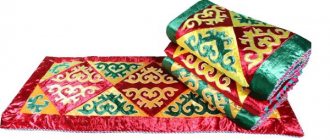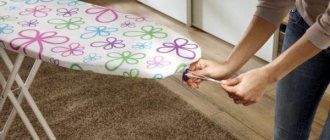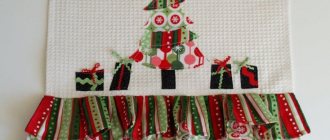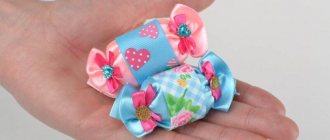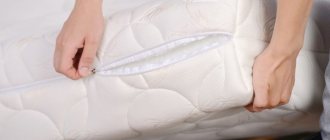A bed with a good, comfortable mattress is the key to a restful, healthy sleep. To keep it clean longer, it is better to use a protective fabric covering that you can make yourself.
The mattress pad should be thick enough to better protect the mattress and securely attach to it.
Not everyone believes that its presence is necessary, but the beneficial properties speak for themselves:
- reliably protects against contamination;
- preserves the original appearance of the mattress for a long time;
- protects against the appearance of allergens and dust on the surface.
A mattress cover or pad primarily performs a hygienic function - it protects the mattress from dirt, it is easy to remove and wash.
How to sew a mattress cover with your own hands
Sewing is not an activity that everyone can do, but almost every housewife can make a mattress cover. You will need to buy the fabric you like, and then:
- acquire dressmaker's tools: scissors, threads, needles, measuring tape;
- prepare the iron;
- set up the sewing machine.
The simplest one looks like a large pillowcase or bag.
To prevent it from “slipping,” you can simulate a button closure or zipper. There are other options for fastening.
Summing up
As you can see, making a mattress with your own hands is quite a feasible task. What is needed for this?
- The desire to see things through to the end and a determined attitude.
- Determination of needs (size, height, desired degree of rigidity).
- A little theoretical knowledge (about the types of fillers, adhesives, fabrics for covering).
- Availability of quality materials.
- Accuracy in work, precision of movements, patience, perseverance.
- The cover and mattress cover can be sewn yourself or to order.
How to sew a mattress cover with an elastic band - simple instructions
A mattress cover with an elastic band assumes the presence of sides
In order for the product to hold firmly, reliable fastening is required in various ways. You can always learn how to sew from expert consultations. For sewing you need:
- prepare sewing tools;
- choose the material you like based on your ideas about the appropriateness of use and beauty;
If the mattress cover should protect only from dirt and dust, choose thick cotton, linen, jacquard, thin terry cloth, bambooIf you also need waterproof functions, we take fabric or material with waterproof lamination
A quilted mattress cover with a thin padding polyester layer is good for winter, it retains heat
Jacquard or silk mattress cover, good in hot weather, as it gives a feeling of coolness
- buy an elastic band – wide or underwear;
- make a pattern by measuring the length and width, and if necessary, the height.
Pattern with allowances for sewing a mattress cover with an elastic band
The order of sewing operations, if the skill is small, can be found on the Internet.
Accessories
When sewing a mattress cover, you will definitely need accessories. It must be strong, flexible and wear-resistant. May be useful:
- Zipper. It should not break or jam when used for its intended purpose, and at the same time, the zipper should be strong and flexible to withstand washes and vibrations of the mattress.
- Rubber. Mattress toppers with corner elastics will require a material that is wide, durable, and flexible. Weaving elastic is suitable; it holds its shape and elasticity for a long time, and tolerates washing well. The elastic band must be of medium width so that it can bend freely, but at the same time it must be strong and elastic. The elastic for use in the drawstring is similar in appearance to underwear, but at the same time it is made of latex threads and covered with polyester fiber, due to which it does not stretch for a long time and does not lose its shape.
- Edging braid. When sewing a mattress cover, edging braid may be needed to strengthen the seams and protect fabric sections from fraying, giving rigidity in the right places.
Case with zipper
We sew a mattress cover with an elastic band with our own hands
Transfer the pattern to the fabric and cut out the mattress cover piece
Correctly folding the edges of the cutouts
A protective covering sewn with your own hands can be the first experience and pride of even an inexperienced craftswoman. To work, you will need a machine, traditional tailor's tools, fabric, accessories, a little skill and effort.
We sew and process the edges of our cutouts on all sides
We bend and iron all the free edges of the mattress cover
We sew the hem around the entire perimeter, leaving an opening about 4-5 cm wide
When choosing a material, you should pay attention to strength: it should not quickly wear out or tear.
Using a safety pin, thread the elastic into the drawstring
We cut the elastic a few centimeters longer than necessary, fold its ends, sew several times, closing the elastic in a circle
Having made measurements: length, width and height, you can start creating a pattern, and then sewing. Fastenings are sewn in along the edges, reliability is checked by fitting.
We sew up the remaining hole - the mattress cover is ready
Sew in an elastic band
There are several ways to sew elastic into a mattress cover. For example:
- Use an elastic band; the elastic is sewn onto the folded fabric using a zigzag stitch.
- The corner method is when pieces of elastic attached to the fabric grab the mattress at the four corners, preventing the fabric from moving.
- The standard method is to create a drawstring into which the elastic is pulled.
Note! In order to beautifully sew in an elastic band, one of the corners must be pre-processed, leaving a hole in it for pulling the elastic through, and the remaining corners must be stitched in the usual way. Insert an elastic band into the remaining hole using a pin and tighten it.
The final touch is to insert the elastic
It is more convenient to do this by pulling the cover over the mattress so as not to make a mistake with the length of the elastic band. Having stretched the elastic on the mattress, you can easily trim off the excess length and tie or sew the edges of the elastic together.
You might be interested in this: Construction of a pattern and the order of sewing a four-piece skirt
How to sew a mattress cover: step-by-step instructions
In order to make our future cover, we need to measure the length of the mattress a, width b, and side height h
The need to protect the product from contamination is quite justified: with its help, it stays clean longer and maintains an attractive appearance. The sequence of work can be learned from simple instructions, which will not be difficult to implement even for a novice home craftswoman:
- buy fabric;
- prepare tools for cutting and sewing: sewing machine, measuring tape, thread, needles, scissors, chalk, elastic band, iron;
- take exact measurements.
Attention! Before you start cutting, it is important to wash the purchased material: it can “shrink”.
We set aside ½ the width of the mattress from the fold line, on each side we set it aside to the left, to the right, and from the bottom h+15 cm
Cut out squares at the corners with scissors
Experienced home craftswomen advise carefully checking the dimensions of the product before cutting.
Advice. For inexperienced housewives, it is better to make a life-size template and check the correctness of certain dimensions.
We transfer the pattern to the fabric, sew down sections C and C1, process the edges of the cut, and make a hem stitch along the entire product
Once the check has been completed, you can begin cutting, having first ironed the fabric well. The main part is cut taking into account the length and width, then 4 side fragments are cut out if the mattress is high.
We retreat from the corner 50 cm, thread the elastic, secure the ends of the elastic with stitches - we get gathering in the corners
All parts are double stitched and folded inside out, then turned inside out.
If the fitting was successful, you can create a drawstring. Iron the finished product.
Ready-made mattress cover with elastic band with gathering in the corners
What materials and tools will you need?
Making a mattress cover with your own hands is not difficult; even someone who only saw a sewing machine in school during sewing lessons can handle it.
- Measurements. First, measure the length, width and thickness of the mattress to cut a piece of fabric. The piece of material should be:
- length of at least two mattresses;
- at least two widths;
- for a model with sides, the thickness of the mattress multiplied by 4 is added to the four sides of the fabric.
For the case with elastic bands at the corners, the thickness is not taken into account.
- Choice of material. The fabric from which the cover is made is selected that meets the specified requirements:
- if the sheet should protect only from dust and dirt, then linen, cotton, bamboo and terry material are suitable;
- to protect the mattress from moisture, choose a material with a waterproof layer;
- if it is important that the bed retains heat longer, the mattress cover is made of quilted fabric;
- when the temperature in the apartment drops significantly, a layer of padding polyester is sewn on;
- help keep foam mattress covers and covers made of woolen material with a fleece layer warm;
- on hot days, it is better to cover the mattress with a jacquard or silk cover.
Before purchasing, keep in mind that silk is more difficult to work with. It slips, and sewing from such fabric is more difficult than from jacquard.
You can sew the waterproof lining yourself by purchasing it separately. The main thing is not to confuse the size, because the seam on the bed feels great.
To secure the cover, select:
- wide elastic bands, the number depends on the mattress cover model: either 2 pieces on opposite sides, or 4 pieces in the corners;
- linen elastic is designed for a size 45 cm shorter than the perimeter of the mattress.
- Preparing tools. To make a cover you will need not only fabric, but also:
- streams;
- scissors;
- pencil for light fabric;
- chalk or bar soap for dark fabrics;
- construction tape or measuring tape;
- legs;
- sewing machine.
You won't have to worry about pencil and soap marks left on the fabric. They will wash off during washing.
How to sew a mattress cover for a baby
You can make a cover for a children's mattress with a zipper yourself
It is very easy to make a cover for a children's mattress. How to sew it yourself is easy to understand from the recommendations. You will need:
- take measurements;
- purchase and wash fabric;
- prepare tailoring tools and machine;
- cut out two rectangles: one to size, the second with an allowance of 2-3 cm on each side.
Three sides and part of the fourth, where a zipper or buttons will be sewn, are stitched and stitched by hand.
When a zipper is used, it is first basted and tried on. If everything is done correctly, it is sewn into place. After ironing, the cover can be put on.
How to make a mattress smaller at home?
If for some reason the finished mattress cannot be returned, but needs to be reduced in size (shortened, narrowed), you will need to perform 5 simple steps.
- Undo the sheathing on the desired side.
- Use a marker and a long strip to mark.
- Cut off the springless block (if necessary, disconnect part of the spring block).
- Shorten (narrow) the sheathing accordingly.
- Carefully sew up the cover.
DIY mattress cover for children and adults
For a mattress for a child and an adult, the covering is made according to the same pattern. This takes into account the material, quality and texture, in accordance with the purpose of use.
The main conditions for a good result are:
- strict adherence to dimensions;
- washing the fabric before cutting;
- careful handling of corners;
- the reliability of the fastener or the correct fastening.
When choosing a fabric, especially when it comes to a children's product, it is important to pay attention to its composition, which should not cause allergies.
Pattern for the case
Before you start cutting out, choose what type of mattress cover to sew. A sheet with elastic bands in the corners is pulled together at the corners; if desired, a padding polyester layer is sewn to it. A mattress topper with sides has an elastic band around the perimeter of the fabric. This case holds more firmly, because the sides go under the mattress, and there the edges are tightened with an elastic band.
- Case with corner elastic bands. They can do without a pattern, because this option is easy. You only need a sheet of paper to take measurements and make a drawing. If the mattress is orthopedic, then you will need to transfer the shape of the corner onto paper, since they are often rounded. This corner is cut out and applied to the fabric as a template.
- Mattress cover with sides. The principle of operation is almost the same as for the previous case:
- measure length, width and thickness;
- take all measurements and make a drawing;
- make a template for the corners;
- cut out the base of the cover;
- cut out the side stripes.
The width of the strip for the side is equal to the thickness +1-2 cm for the allowance +10 cm (what is under the mattress) +3 cm for sewing on the elastic.
When drawing a drawing, take into account seam allowances of 1-2 cm;
Pattern for a mattress cover with corner elastic bands
We pin the elastic bands to the corners of the mattress cover from the inside out
The model is quite simple. Elastic bands are sewn along the edges of the cut out rectangles to secure them to the surface of the mattress. The pattern can be found on the Internet.
Having folded the rapeseed tape in half lengthwise, we pin it along the entire perimeter of the mattress cover, grab the ends of the elastic, and stitch
We create a comfortable mattress ourselves
Having decided to create an orthopedic mattress with your own hands, you need to consider a number of points.
- Qualities. Making a mattress with your own hands is quite possible. It can even be exciting. However, if you intend to get a quality product, you cannot do without accuracy, perseverance, patience and scrupulousness.
- Theory. If you only have the desire, but no special skills or even theoretical knowledge, it would not hurt to read several articles about the types of modern fillers and their properties, the required degree of mattress hardness and the materials used for sewing covers.
- Materials. The search for the materials themselves - blocks or layers of filler, special glue and fabric for covering - is a crucial moment. The degree of difficulty in finding high-quality, durable and safe materials will depend on the region in which you live. A big city means great opportunities, where there is an abundance of assortment. Residents of small towns and villages will have to spend time searching for a reputable manufacturer on the Internet and pay extra for delivery.
- Tools. Next, you will need to ensure that you have the necessary tools for the job.
- Case. If you don’t know how to sew, you need to think about someone who can help you calculate the amount of fabric for the cover and can make it.
If you have high-quality materials and a careful approach to business, you can count on quite good results!
Cover for orthopedic mattress
An orthopedic mattress is expensive, so a cover for it will also be expensive, and many housewives sew it themselves. In order for the result to please you, the fabric needs to be:
- antistatic;
- hypoallergenic;
- breathable;
- did not absorb moisture;
- did not accumulate dust.
Jacquard is considered the most suitable, dense, durable, with a variety of colors.
You can use natural linen, cotton, as well as synthetic and mixed fabrics that do not cause allergies.
Choosing fabric for a mattress cover
You can use almost any fabric for a mattress cover. But there is also a division of fabric types according to the purpose of the cover. For example, the fabric could be:
- hypoallergenic;
- waterproof;
- heating;
- synthetic;
- kit;
- natural.
For a regular mattress cover, natural fabrics (linen, satin, calico) are still recommended. They are light, breathable, do not cause allergic reactions and wash very well.
Natural fabrics tend to shrink, so before sewing it is recommended to wash the cut in hot water and iron it well.
Synthetic fabrics are cheaper, absorb moisture well and are suitable for allergy sufferers. Another advantage of synthetics is wear resistance. They are more durable, do not lose color and are easy to wash. If there are no contraindications, it is quite possible to use synthetics (for example: microfiber or polycotton).
You can also use quilted fabrics such as blankets, down or foam for the cover.
Soft case
Of course, you can choose any color of fabric, some prefer bright shades with patterns or colors, but do not forget that the cover will come into contact with moisture (sweat, accidentally spilled water, wet hair), and rich colors may fade and leave a mark on your underwear beds. Therefore, it is preferable to choose calm shades without unnecessary patterns.
It is better to choose a calm color
Photo gallery of different types of mattress covers for children and adults:
PreviousMattressesWhich mattress is better, more practical: spring or springless?
Next
MattressesHow and with what to seal an intex air mattress at home?
How to make a mattress harder or softer?
A topper is a thin mattress - a product that helps correct hardness. Models made of latex, soft polyurethane foam or holofiber will add softness to the sleeping surface. Latexed coir is a hard filler.
Reference! Like a mattress, you can make your own topper.
How to sew a zipper to a sofa cushion cover
Do not use metal zippers or tractor zippers for the cover. Buy an inexpensive, one-piece twisted zipper, 60-70 cm long, which can be easily shortened.
To sew a zipper along the edge of the cover, use a special zipper foot.
Now secure the second part of the zipper with pins; it is not necessary to baste the lock tape to the edge of the case with threads.
Removable or non-removable cover
As mentioned above, the cover can be removable or not. Mattresses are placed in non-removable covers during their production. And the best option would be a second mattress cover, removable and put on top of the stationary one. There are original mattress covers with a fastener. Such mattress covers are convenient when purchasing a mattress, because by unzipping the zipper, you can make sure that the mattress is actually made from the material stated.
But removing such a cover for washing is very inconvenient, because it is made of thick, heavy fabric and will not fit into every washing machine. Sewing a non-removable cover is all the more irrational, because its most important function is to keep the mattress clean, and, accordingly, it itself must be clean.
A removable mattress pad usually has a zipper. It can be located along the entire perimeter of the mattress, only on one side, at an angle, covering one side in length and the side adjacent to it in width. The fastener can also be button, Velcro, lace, elastic, and so on.
Important! It is not necessary to sew a removable mattress pad in the form of a cover covering the mattress on all sides. It’s more convenient to make it hide only the top and side parts, and only slightly capture the bottom, tightening it with an elastic band
conclusions
Knowing all the secrets of how to properly sew a zipper into a pillowcase or pillow case, every housewife will be able to cope with this work independently. Using your design imagination, you can easily sew uniquely interesting types of pillowcases from fabrics of different textures, coming up with a variety of design elements. A zipper on the products will make the pillow not only more attractive and neat, but also convenient during use. Select high-quality zippers up to 70 cm long. Cut off the excess piece of zipper at the final stage of sewing.
Removable or non-removable cover
Modern equipment allows us to produce mattresses with removable covers. To do this, a cover is made, which is then put on the mattress. There is no tight fit between the fabrics and the filler. Removable models are characterized as practical and, if necessary, allow you to remove and wash the cover or take the product to the dry cleaner. It is problematic to put on and take off the mattress yourself. Some materials shrink greatly after washing, making subsequent use almost impossible.
Removable models do not fit tightly to the structure, unlike non-removable models. The surface of the material may be slippery and wrinkles may form in the corners. This will lead to a decrease in the service life of the mattress and loss of orthopedic properties. Edging equipment makes it possible to produce non-removable covers. In this case, the material will be sewn to the filler of the finished structure. The adherence of the material to the filler will be excellent, but it will be almost impossible to do anything if the surface is heavily contaminated.
Removing covers is not recommended by experts, who claim that the best way to remove dirt and put the product in order is to call dry cleaning at home. The cover cannot be cleaned on your own. Mattress covers will help prevent stains and signs of wear on the product. The cover is easy to remove and can be washed frequently. The main requirement is the breathability of the selected material, its strength, hydrophobicity and elasticity. In the manufacture of mattress covers, a special type of material is used that provides excellent air exchange.
Evaporating moisture will not allow insects and harmful microorganisms to grow inside the mattress structure. The absence of dust will prevent the formation of allergic reactions. Covers made of wool, linen and cotton are characterized by a high level of strength. Jacquard is considered the most durable and wear-resistant material. Cheap mattresses are dressed in polycotton. The most commonly used stretch is cotton-based. Orthopedic products are sheathed with natural fabrics that contain synthetic fibers that make them elastic. Hydrophobicity will protect the product from moisture, mold, and unpleasant odors.
Source
Technology of sewing a cover for a sofa cushion
If you have had to sew your own bed linen, then sewing a cover for a sofa cushion will seem even easier. The fact is that the seams of the pillowcase must be covered either by overlocking or using a linen seam, but for a cover or a sofa cushion such treatment is not required. However, if possible, you can overlock the seams, especially if the cover is made from different pieces of fabric, as in my master class.
Be sure to steam iron all seams before fully assembling the cover (packing).
To make the seams stronger, you can sew a finishing stitch at 0.6 - 0.8.
A cover made from two fabrics of different colors and textures looks much more impressive, and most importantly, you didn’t have to buy quite expensive furniture fabric.
To prevent the edges of the furniture fabric from fraying after washing the cover, it is advisable to overcast all sections of the fabric.
Benefits of a branded product
If the DIY process turns out to be too complicated or there is simply no time for it, you can turn to traditional methods and purchase a branded product. The Molto Bene company offers options for Italian mattresses for every taste. A wide range of inexpensive and affordable models, original and exclusive options.
And in conclusion, I would like to note that the main advantages of high-quality mattresses are sound and healthy sleep, the adoption of an anatomical position for the spine and joints. The design of the mattress is designed in such a way as to relieve tension from the entire body and allow muscles to relax.
PLEASE SHARE THIS POST!
